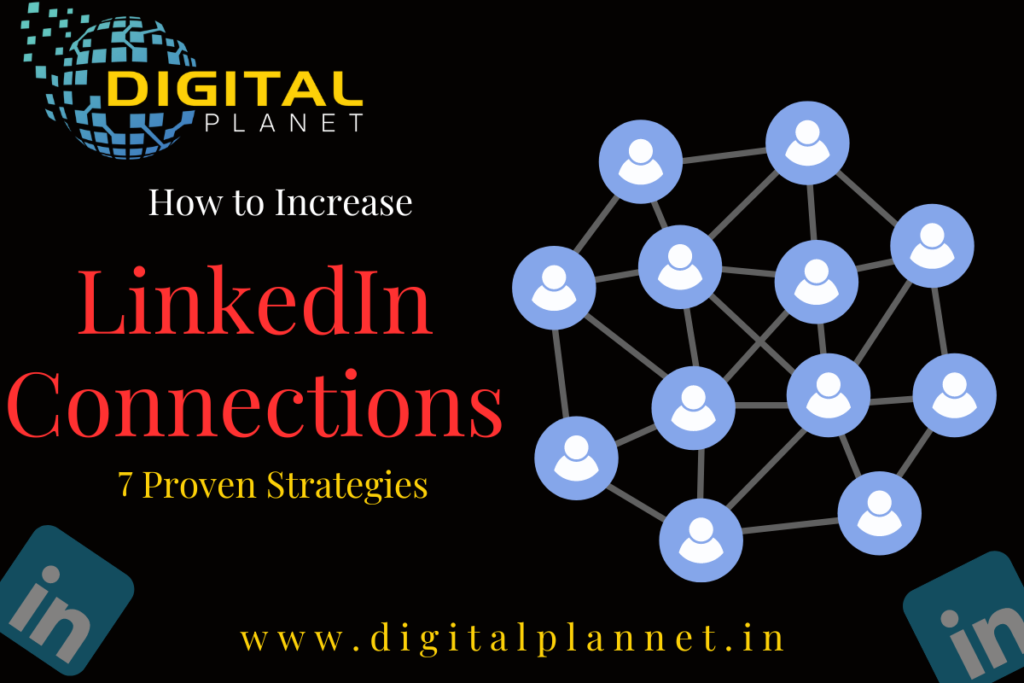What is LinkedIn Connection:
LinkedIn connections are the network of professional contacts you have on LinkedIn. These are people you’re directly connected to through accepted connection requests. LinkedIn Connections can include colleagues, classmates, industry peers, mentors, and other business professionals. On LinkedIn, connections are key—they let you communicate, share insights, and build relationships. Having more connections can boost your visibility and open doors to career opportunities, collaborations, or industry insights. LinkedIn Connections are a foundational part of building your professional network and expanding your reach in your field.
How to Increase LinkedIn Connections: 7 Proven Strategies:
LinkedIn is a powerful platform for building professional connections, showcasing skills, and exploring new career opportunities. With over 700 million users, it’s the go-to network for professionals across industries. To get the most out of LinkedIn, it’s crucial to grow your connections effectively. In this article, we will discuss 7 proven strategies to increase your LinkedIn connections and build a strong professional network.
1. Optimize Your LinkedIn Profile:
A well-optimized LinkedIn profile is the foundation for attracting new connections. Make sure your profile is complete and engaging. Include the following elements:
Professional Headshot: Use a high-quality, professional photo that clearly shows your face.
Compelling Headline: Write a headline that reflects your skills and expertise. Avoid generic titles like “Job Seeker” or “Professional.”
Detailed Summary: Write a summary that tells your story. Include your skills, experience, and career goals. Use bullet points for clarity.
Experience and Education: Provide detailed information about your work experience and educational background.
Skills and Endorsements: Add relevant skills and request endorsements from colleagues and peers.
Optimizing your profile helps you stand out and makes it easier for others to find and connect with you.
2. Engage with Content on LinkedIn:
Consistent engagement with content on LinkedIn can increase your visibility and attract new connections. Here are some ways to engage effectively:
Like and Comment: Regularly like and comment on posts from your connections. Add thoughtful comments to demonstrate your expertise.
Share Valuable Content: Share articles, blog posts, or industry news that would interest your network. Add a brief commentary to showcase your perspective.
Participate in Discussions: Join LinkedIn groups relevant to your industry and participate in discussions. Share insights and engage with other group members.
Engagement is key to building relationships on LinkedIn and increasing your visibility.
3. Send Personalized Connection Requests:
When sending LinkedIn connection requests, avoid generic messages. Personalize each request to increase the chances of acceptance. Here’s how to do it:
Mention a Common Interest: Highlight a shared interest or common connection. This can be a mutual group, industry, or event.
Explain Why You Want to Connect: Briefly explain why you’re interested in connecting. Mention how you can add value to their network.
Express Gratitude: Thank the person for considering your request and express excitement about connecting.
Personalized connection requests are more likely to be accepted, leading to a stronger network.
4. Leverage LinkedIn Groups and Events:
LinkedIn groups and events are excellent opportunities to connect with like-minded professionals. Here’s how to use them effectively:
Join Relevant Groups: Search for groups related to your industry or interests. Join a few active groups and participate in discussions.
Attend LinkedIn Events: Look for virtual events and webinars on LinkedIn. Attend these events and connect with attendees.
Follow Group Rules: Adhere to group rules and guidelines. Avoid spamming or self-promotion. Instead, focus on adding value to the discussions.
By engaging in groups and events, you can expand your network and find new connections.
5. Use LinkedIn’s Advanced Search:
LinkedIn’s advanced search feature allows you to find specific professionals to connect with. Here’s how to use it effectively:
Set Search Criteria: Define your search criteria, such as industry, location, job title, or company.
Use Filters: Apply filters to narrow down your search results. This can include past companies, schools, or shared connections.
Reach Out with a Personalized Message: When you find potential connections, send a personalized connection request using the approach mentioned earlier.
Advanced search helps you target specific professionals and build a network that aligns with your goals.
6. Publish Thought Leadership Content:
Publishing original content on LinkedIn can establish you as a thought leader and attract new connections. Here’s how to do it:
Write Articles or Posts: Share your expertise by writing articles or posts on LinkedIn. Focus on topics relevant to your industry.
Add Visuals: Include visuals like images, infographics, or videos to make your content more engaging.
Promote Your Content: Share your articles or posts with your network and relevant groups. Encourage others to share and comment.
By publishing thought leadership content, you can position yourself as an authority in your field and attract new connections.
7. Follow Industry Influencers and Companies:
Following industry influencers and companies on LinkedIn can help you stay updated and connect with professionals in your field. Here’s how to do it:
Identify Key Influencers: Find industry influencers with a large following. Follow their profiles and engage with their content.
Follow Companies: Follow companies in your industry or those you’re interested in working for. Engage with their updates and job postings.
Connect with Followers: When you engage with influencers’ content, connect with other followers who share similar interests.
By following industry influencers and companies, you can expand your network and stay informed about industry trends.By implementing these seven proven strategies, you can increase your LinkedIn connections and build a strong professional network. Remember to stay active, engage with your network, and always personalize your interactions.
What is the weekly limit for linkedIn connections?
LinkedIn has set a weekly limit of around 100 connection requests to ensure quality interactions and prevent spam. This encourages users to be selective in networking, maintaining a professional environment focused on meaningful relationships. If you exceed the limit, you’ll have to wait until the next week to send more requests. Understanding and adhering to this limit is important for strategic network expansion on LinkedIn.
What is the maximum linkedin connections?
LinkedIn allows a maximum of 30,000 connections per user account. Once you hit this limit, you can’t send or accept more connection requests, though you can still have unlimited followers. This limit is generally sufficient for most users. If you reach it, focus on engaging with followers and building quality relationships within your existing network.
What is the difference between linkedIn connections and followers?
LinkedIn connections and followers serve different purposes on the platform, reflecting different types of professional relationships. Connections are reciprocal relationships; when you connect with someone on LinkedIn, both parties agree to be connected, enabling more direct interaction, such as messaging and sharing profile updates. It represents a two-way street, similar to a “friendship” on other social platforms, where both individuals can see each other’s updates and engage directly.
On the other hand, followers are one-way relationships. If someone follows you, they will see your public posts and updates in their feed, but you do not necessarily follow them back. This feature is useful for thought leaders, influencers, or companies that want to share content with a broader audience without needing a mutual connection. In essence, connections imply a more interactive relationship, while followers focus more on content consumption.
Is it safe to buy linkedin connections?
Buying LinkedIn connections is risky and violates LinkedIn’s terms of service. It can lead to account suspension or a permanent ban. Purchased connections are usually low-quality and lack genuine engagement, damaging your professional credibility. Instead of buying connections, focus on organic growth by engaging with your existing network and participating in industry groups. This approach leads to authentic relationships and real career opportunities.
Conclusion:
Increasing LinkedIn connections involves building relationships, engaging with content, showcasing expertise, optimizing profile, personalizing connection requests, participating in groups/events, leveraging advanced search, publishing thought leadership content, and focusing on quality over quantity. Implementing these strategies helps build a robust LinkedIn network that opens doors to new opportunities.
Frequently Asked Questions:
Q1: Why is it important to have more LinkedIn connections?
A larger network can increase your visibility on LinkedIn, leading to more career opportunities, industry insights, and potential collaborations. It also helps you stay updated on industry trends and expand your professional reach.
Q2: How can I find people to connect with on LinkedIn?
Start with your existing network—colleagues, classmates, and industry peers. Use the search function to find people based on your industry, school, or shared interests. Explore “People You May Know” for additional suggestions.
Q3: What should I include in my connection request message?
Personalize your message by mentioning how you know the person or why you’re interested in connecting. Avoid generic messages; instead, reference shared experiences, mutual connections, or common industry interests to make a stronger impression.
Q4: How often should I send LinkedIn connection requests?
There’s no strict rule, but avoid sending too many requests at once, as this might trigger LinkedIn’s spam filters. Aim for quality over quantity, focusing on meaningful connections rather than random ones.
Q5: What can I do to make my profile more appealing to potential LinkedIn connections?
Complete your profile with a professional photo, detailed work experience, and a clear headline. Write a compelling summary that highlights your skills and expertise. Also, engage in LinkedIn activities like sharing content and commenting on posts to show you’re active on the platform.
Q6: How can I maintain and strengthen my LinkedIn connections?
Engage with your connections by liking, commenting, or sharing their posts. Send them messages to congratulate them on milestones or simply catch up. Participate in LinkedIn groups related to your industry to build stronger relationships.
Q7: What if someone doesn’t accept my LinkedIn connection request?
If a request isn’t accepted, don’t take it personally. Give it some time, and consider sending a follow-up message if you have a valid reason to connect. If there’s still no response, focus on building LinkedIn connections with others who share similar interests or professional backgrounds.
Q8: Can I connect with people I don’t know on LinkedIn?
Yes, but it’s best to have a reason for connecting. Explain your interest in your connection request and avoid being overly promotional. LinkedIn is about building professional relationships, so focus on genuine networking rather than merely increasing numbers.
Q9: How can I leverage LinkedIn groups to grow my LinkedIn connections?
Join groups relevant to your industry or interests, and actively participate by sharing content, asking questions, or commenting on discussions. This can help you meet new people and establish common ground for future LinkedIn connections.
Q10: Are there any LinkedIn features that can help me connect with more people?
LinkedIn’s “People You May Know,” “Alumni Tool,” and “Connections of” features are excellent for discovering potential connections. Additionally, LinkedIn’s content recommendations and shared activity updates can guide you toward people with similar interests.
Related Posts
- Best AI for Video Generation Free 2025: Ultimate Guide + Top Picks
- How to Get Invite Code for Sora 2 (2025): The Ultimate Step-by-Step Guide
- Influencer Marketing for Travel Industry 2025
- Top 10 Motivational YouTubers in India-Must Follow in 2025
- Boosting Health & Fitness Brands with Influencer & UGC Marketing

